UC Los Angeles Football Defensive Preview
Strong pass rush, questionable secondary. Stop me if you've heard this one before.
Oregon, USC, and now UCLA. All teams with a strong defensive line but a questionable secondary. Why do these high-powered offensive-minded teams all have this in common? I was thinking about this today as I prepared to write another defensive article that fit into the same exact formula as many of the previous weeks (4-2-5, strong pass rush, yadda yadda), which gave me a sense of deja vu that I haven’t felt before in previous seasons. And then I realized, it’s probably because it takes a lot of time and good coaching to develop a solid secondary (cf. Utah, Oregon State), whereas it’s much easier for a big-name program to quickly add some high-rated recruits on the defensive line via the transfer portal, and then ask those new guys to just win individual matchups in the pass rush (using techniques and experience they developed at their previous schools). While it’s not surprising that this applies to someone like USC, who rebuilt their entire roster from the transfer portal, it is a little bit of a surprise coming from a Chip Kelly team that insisted on playing an absurd number of true freshmen and sophomores in his early tenure in order to develop players. Consider this: 19 of UCLA’s 27 sacks this season (~70%) came from their recent transfer portal additions.
UCLA’s defensive coordinator (Bill McGovern) has unfortunately missed quite a few games in recent weeks with ongoing health issues, so UCLA has turned to this man to helm the defense:
If there’s anything that you might remember of Pendergast during his previous tenure, it’s that he absolutely loves to bring pressure and hope he can force a quarterback into making mistakes.
The day after Thanksgiving is probably going to be a sleepy atmosphere for a game, which is probably a blessing in disguise for Cal, because UCLA fans are known to be diehards and not at all fair-weather fans who definitely travel well. This is because of how much practice they get traveling to their own stadium:
So without further adieu, let’s take a look at the positions.
Defensive line
First, I want to clarify some nomenclature. UCLA pretty much always shows a 4-man front, but their depth chart lists their two edge rushers as “outside linebackers.” However, those edge rushers pretty much always rush the passer and generally play with the responsibilities of a defensive end, and so I feel they are a better fit for the defensive line section (with just one notable exception dropping into coverage more than the rest, so I’ve included that player in the linebacker section instead).
UCLA’s star pass rusher is actually Cal tight end Keleki Latu’s brother, Laiatu Latu. Laiatu Latu medically retired after a serious neck injury while playing for Washington (he actually sacked Chase Garbers in a UW loss back in 2019). When the UW doctors weren’t willing to clear him to return, he was able to transfer to UCLA, where he could get clearance.
Latu has been an absolute menace for opposing quarterbacks this season, and actually led the FBS in sacks around midseason. He currently has 9.5 sacks, which is the most for a UCLA player since NFL 1st rounder Takkarist McKinley posted 10.0 sacks in 2016. Latu has obvious length advantages and does a good job of converting speed to power, and his lateral quickness is often too much for interior offensive linemen.
He’s a very high motor player:
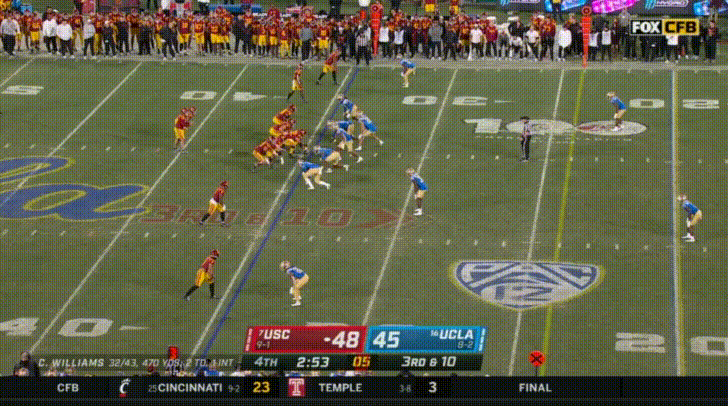
Here Latu uses his speed to blow past the interior offensive lineman:
And here he uses his speed to the outside to beat the tackle:
Here Latu again uses his power before disengaging for the sack:
There are a lot of plays like this, where Latu is able to immediately get hands on the quarterback the moment they think about leaving the pocket. Latu always tracks them down, and has been a constant disruptive force in the opposing backfield:
Although Latu leads the team in sacks by a wide margin, the starting defensive ends outside linebackers are quite literally a pair of transfers from North Texas, the twins Grayson and Gabriel Murphy. Both of the Murphy twins are known for their initial quickness:
Here’s another example of that initial burst, with both Murphys ending up near the QB:
Here Gabriel Murphy uses his speed to the outside to strip sack the quarterback from behind, although it was negated by a penalty:
I noticed this a lot with the Murphy twins. They rely on that initial quick first step, and will often try to time the snap:
I would love to see make Cal make some sort of adjustment specifically to mess with the Murphys and their timing. It’s hard to block someone who is already coming at you with a full head of steam when you’re just making your first step. Although Latu is likely to maul whatever offensive tackle is placed in front of him, I think it would be effective to try and neutralize their other pass rushers’ best weapons.
Bo Calvert was originally a box defender, but has since been moved to an edge rusher. He’s yet another effective edge rusher for UCLA, showing that they have a lot of depth along the defensive line to help stay fresh late in games:
On the interior of the line, there has been one constant: the 6’3” 325 lbs. defensive tackle Jay Toia. Toia is a big presence on the defensive line, but he’s not the most efficient tackler. Still, it’s probably advisable not to get flattened by him:
The other defensive tackle position has seen a variety of players: Martin Andrus (injured), Jacob Sykes, Gary Smith III, etc. Although Cal will have to contend quite a bit with the edge rushers, they aren’t the only pass rushers that will cause Cal some trouble.
Linebackers
Another one of UCLA’s outside linebackers (who at least plays more like a linebacker) is Carl Jones Jr. He seems to be the one most likely to drop into coverage in passing situations relative to the other “OLBs” (and the UCLA roster lists him as “LB” instead of e.g. “DL” like the Murphy twins). It probably helps that Jones Jr. is also closer to a linebacker in size (228 lbs vs e.g. 265 lbs for Latu). Here, the smaller Jones Jr. is just way too fast for the right tackle:
And here Jones Jr. does a good job of recognizing the play is a pass, and then following the quarterback’s eyes to drop back into coverage for an interception:
There’s one key player to watch at linebacker, and that’s the Hawaii transfer ILB Darius Muasau. Muasau has fantastic instincts as a middle linebacker and is just an overall well-rounded college player (I think he’ll get some looks at the next level, perhaps on special teams, but not sure how his game will translate to the next level against the elite athletes you see in the NFL).
Muasau plays with great instincts and generally finds himself in the middle of the action. He’s a solid run stopper, and here he stuffs ASU’s wrecking ball running back X Valladay at the goal line:
Another tough man to bring down is Utah’s quarterback, Cam Rising. Here Muasau both stuffs Rising’s 4th down conversion attempt, and also manages to put a helmet on the ball to force a fumble and turnover for UCLA:
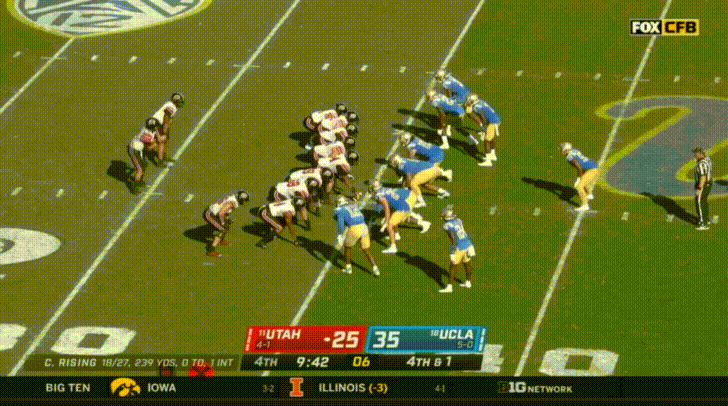
Muasau also has great instincts in pass coverage. In the following play, Stanford is trying to open a passing lane by using the threat of the run, but Muasau is not fooled, and he drops back to make the interception:
Similarly, he functions in sort of a robber role on the following play, again fooling the quarterback into thinking a throw is there when it’s not:

UCLA will run a very aggressive defense, trying to blow up screens, jump routes, etc. UCLA’s best pass-defending linebacker is the tweener LB/NB JonJon Vaughns (although UCLA has been using him at ILB and a DB in the NB role in recent weeks). Here Vaughns senses the screen pass and jumps the route for an interception:
Vaughns took over the ILB role from Kain Medrano, who’s been less instinctive in pass coverage duties:
Secondary
I’m going to start with the strength of this secondary, which is unquestionably the safety Stephan Blaylock. Blaylock is an athletic defender with good ball skills and tackling ability, and he flies around the field making plays. In the following play, he reads UW quarterback Michael Penix Jr. like a book:
It’s hard to find good examples of tackling ability, but in the following play he both avoids the pick route and sticks the receiver for no gain:
If it doesn’t look that impressive to you, just go back to last week’s Stanford defensive preview for plenty of examples of DBs that can’t tackle and compare.
Although Blaylock is an excellent defender, there’s a bit of a drop-off after him. Their best corner is probably John Humphrey (not to be confused with Stanford receiver John Humphreys), and he’s probably best described as a #2 corner. Humphrey isn’t a bad corner, but most of his coverage struggles have come against teams’ #1 receiver who can too easily out-talent him for the ball. Here Humphrey does a good job shadowing Utah receiver Devaughn Vele, although he never turns his head for the ball:
The other starting corner is anyone’s guess. UCLA has been giving their younger defensive backs more playing time, and the starting corner opposite of Humphrey last week was Jaylin Davies, but the starter earlier in the season was the grad transfer Azizi Hearn (who transferred from Arizona to Wyoming to UCLA).
Here Hearn does a good job of fighting through the catch to prevent the touchdown:
The new starting corner, Jaylin Davies, is a sophomore transfer from Oregon (although I can’t remember him playing anything more than a snap or two in garbage time for Oregon last year). Davies can be described in one word: physical. His entire gameplan is to just hold and tug and yank on the opposing receiver, and just dare the ref to throw a flag on every play. Honestly, I’m not sure how he doesn’t draw more flags. Here he disrupts the route by the Stanford receiver:
And here he pretty much tackles the receiver before the ball even arrives:
Here’s another iffy play, where I thought the refs would call defensive holding (Davies is still interfering even when the ball is in the air), but he’s again able to disrupt the receiver which allows him to step in front of the throw for the interception:
Finally, there’s the other starting safety, Mo Osling III, who is finally a fulltime starter in his 6th season at UCLA. The following play is a classic Pendergast pressure, and the defensive back blitzes off the edge… but no one picks up that uncovered receiver, and I can’t figure out what Osling was doing on the other side of the field while this was happening:
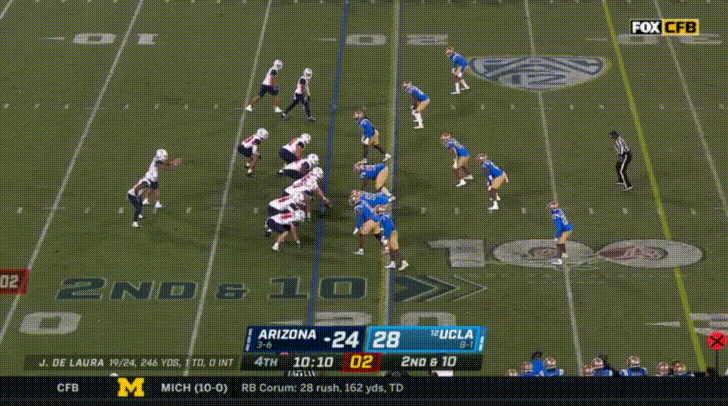
Mo Osling III is actually the team’s leading tackler (not usually a good sign for your rush defense when your safety is cleaning up so many tackles, but perhaps a sign that there’s no one left when UCLA is blitzing or bringing pressure so often), but he’s often on the wrong end of run highlights:
If this season is of any indication, Jack Plummer will be under a lot of pressure, but he’ll also have plenty of opportunities to find his receivers open downfield if he can find the time to throw it deep.
Conclusion
It’s games like these that I hope Jack Plummer has some good health insurance. UCLA has great pass rushers, and they like to bring a ton of pressure. The defense isn’t really worried about getting stops on every drive, just getting a big negative play every once in a while to kill a drive (or force a turnover) so that they can lean on their explosive offense to outscore the other team. I’m not extremely optimistic about the game, considering UCLA’s Achilles heel would be a team that can score at their pace and/or lean on an extremely stout defensive line to shut down the UCLA run game (and Cal is neither of those). However, I thought the same about USC, and Cal somehow turned the USC game into a 6-point game, so it’s not out of the question that a frustrated and/or banged-up Dorian Thompson-Robinson could start making some dumb mistakes and let Cal sneak back into the game. It’ll be a longshot, but probably not as much of a longshot as a UCLA student surviving Cal’s academics or something totally unreasonable.
Go Bears.
You can find my full clips here.


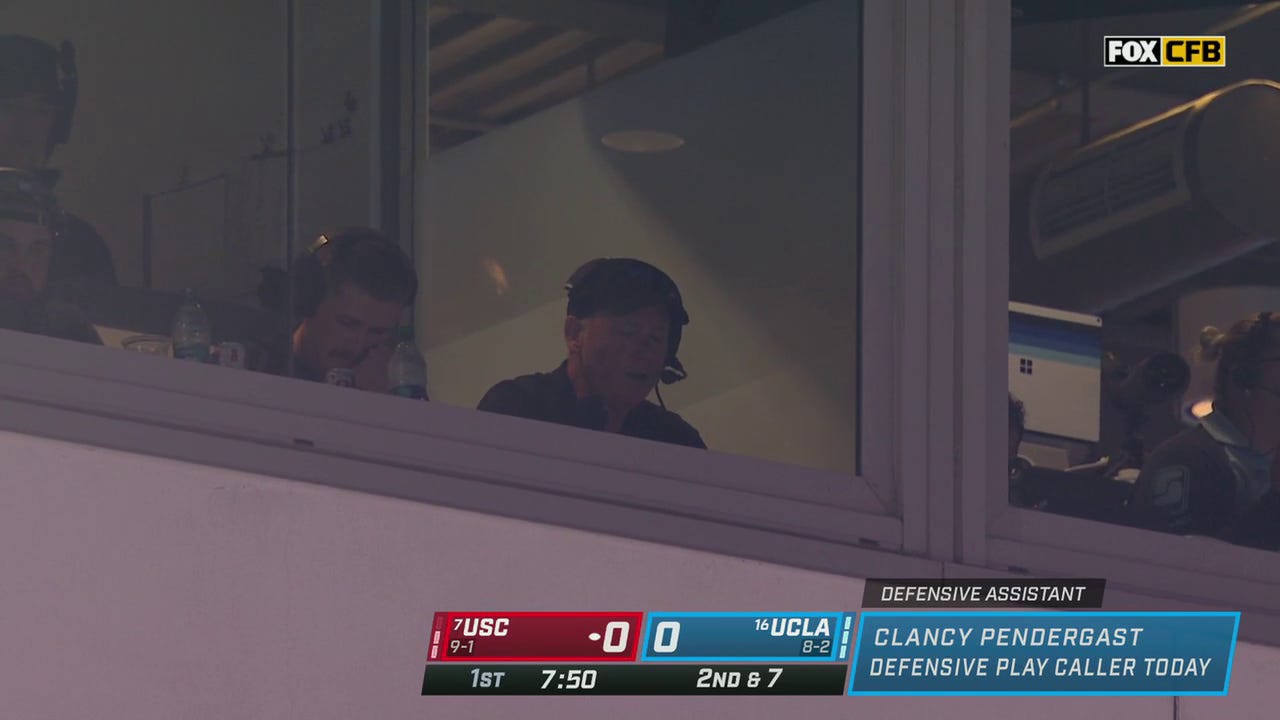
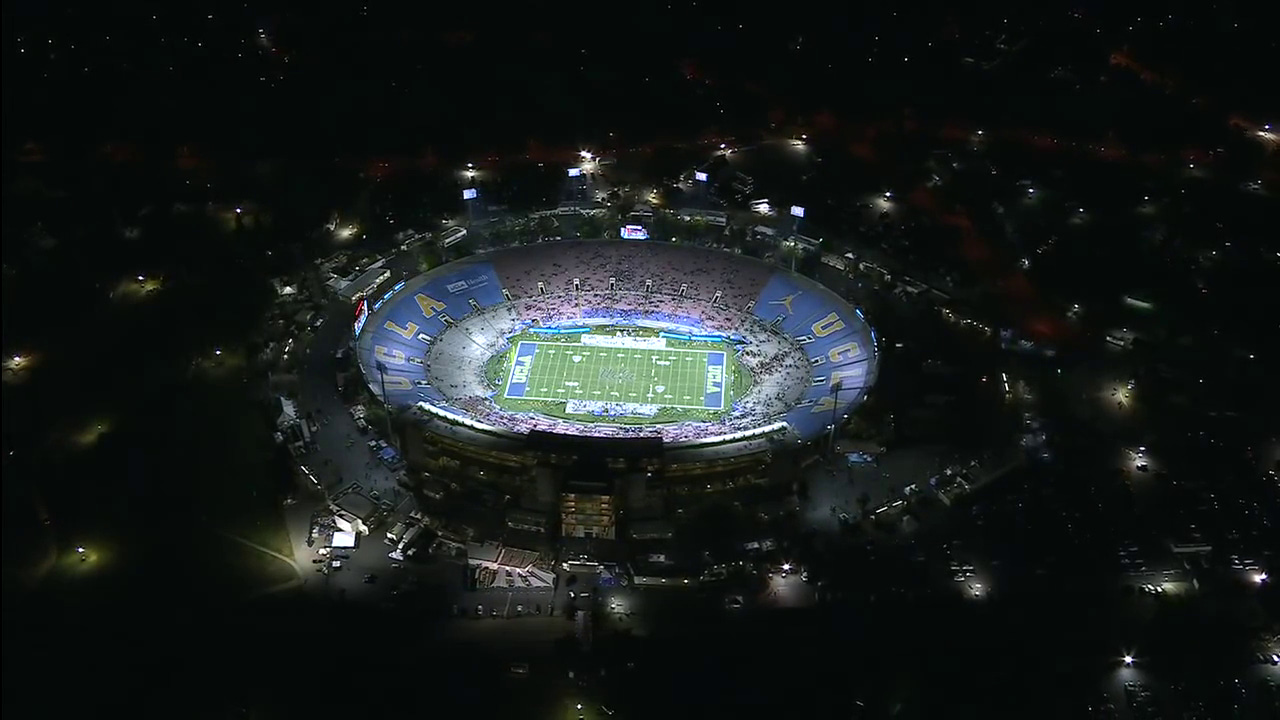
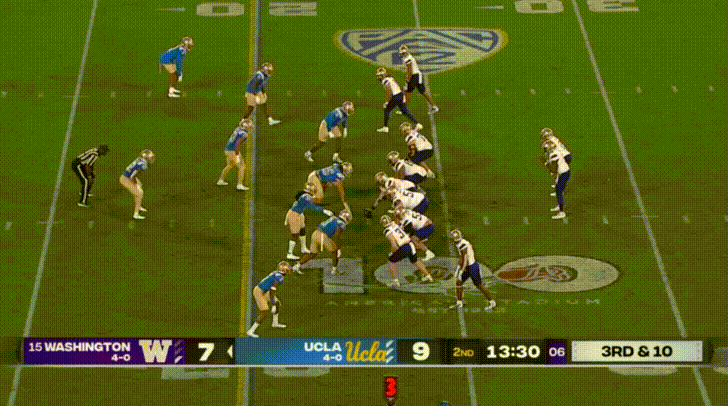
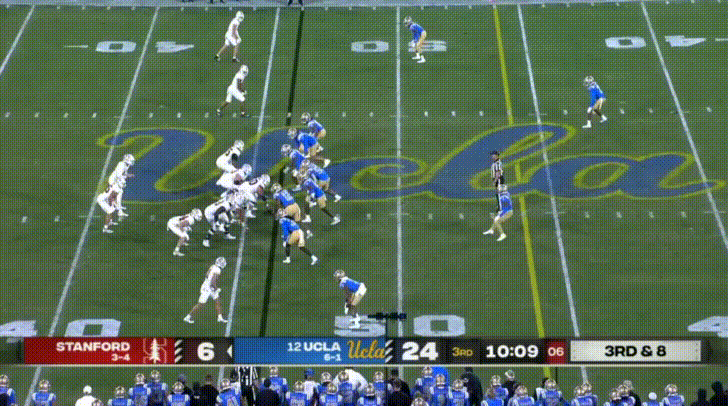
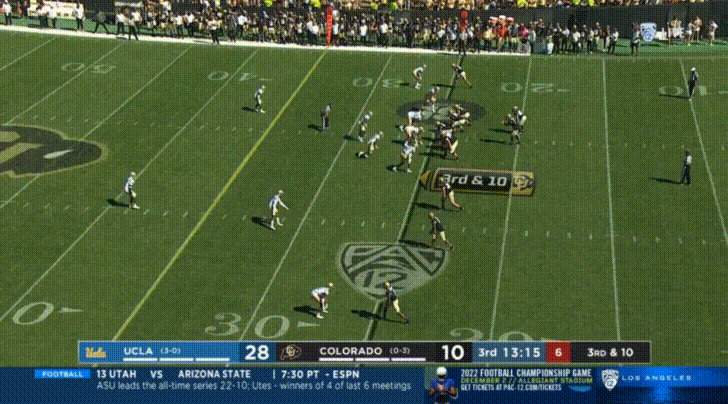
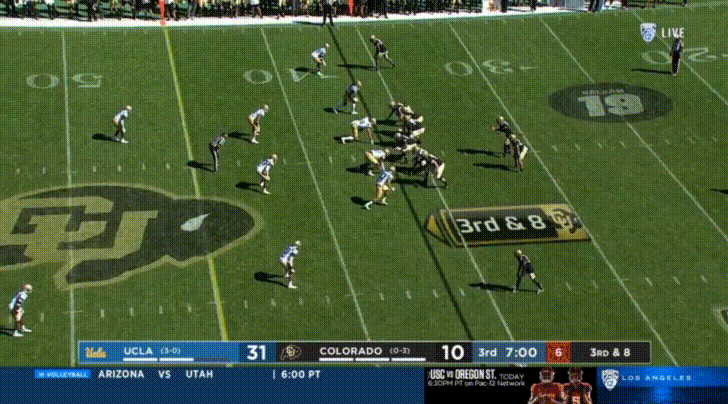
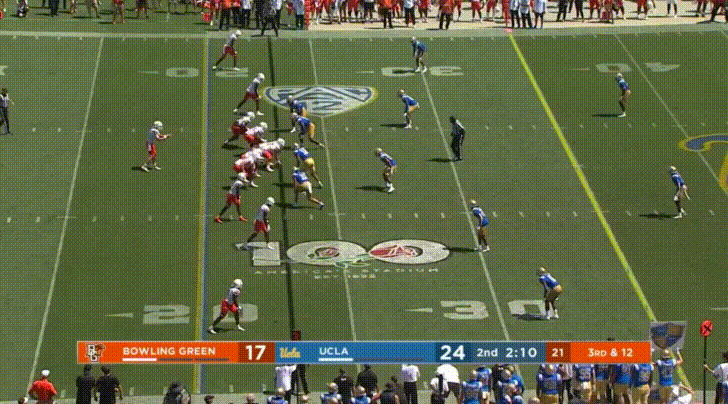
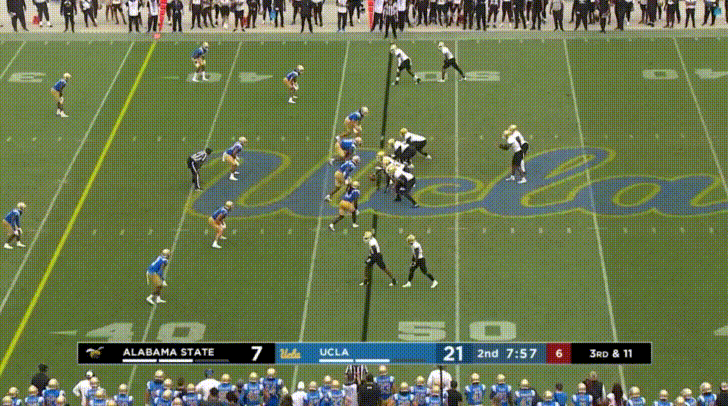
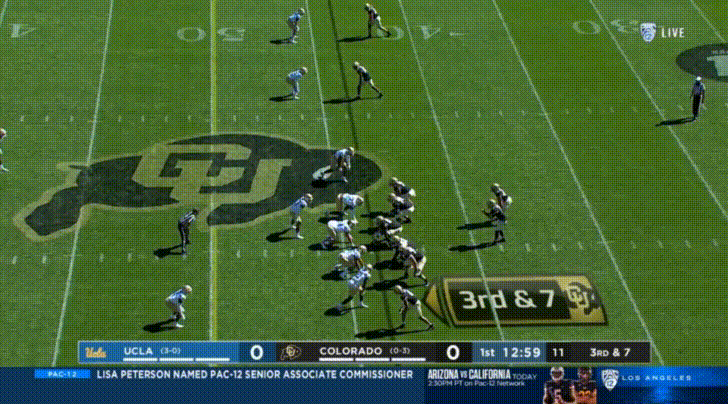

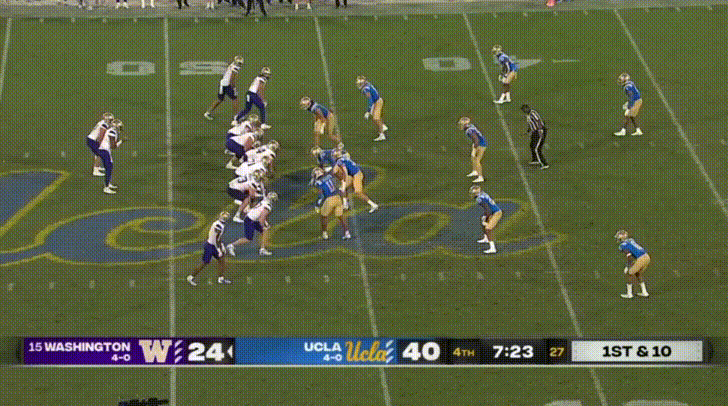
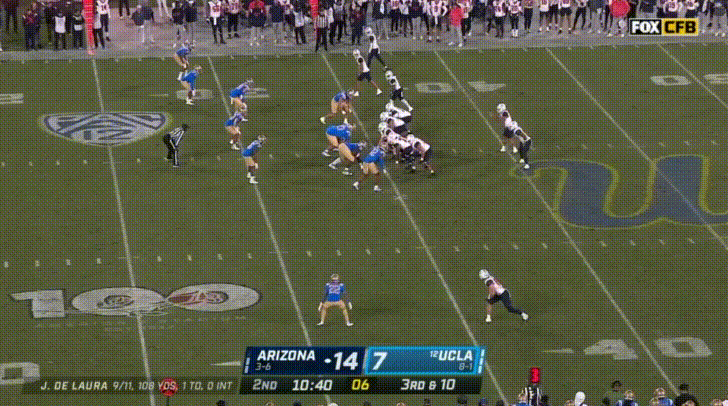
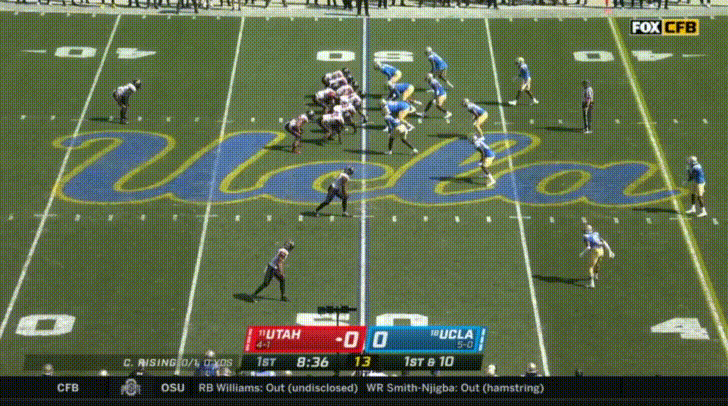
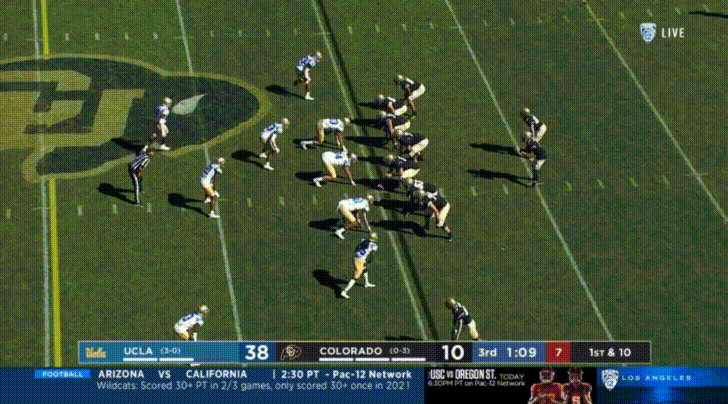
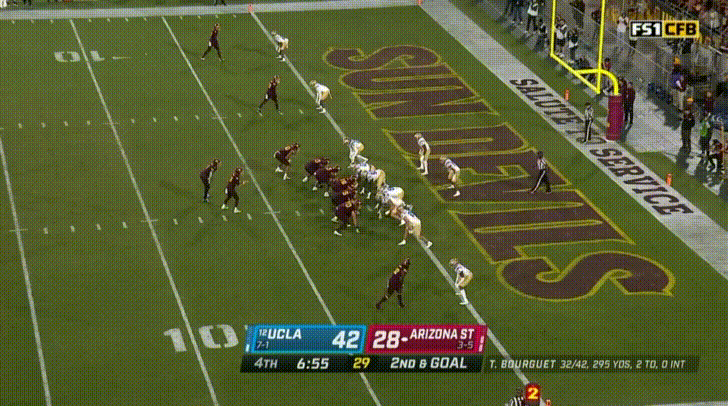
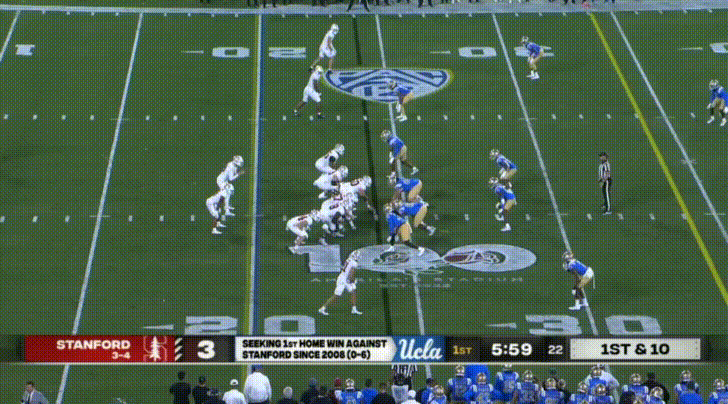
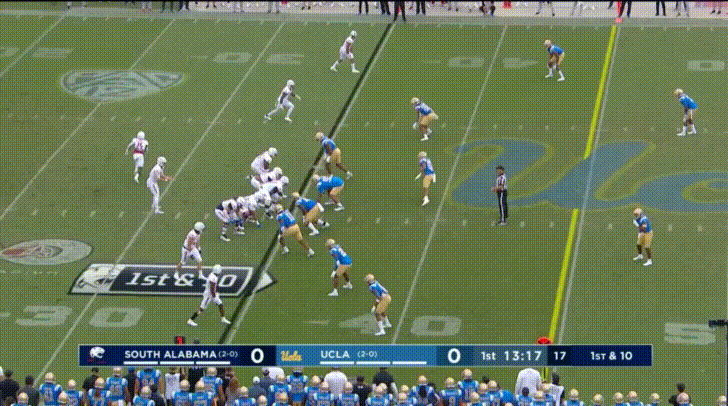
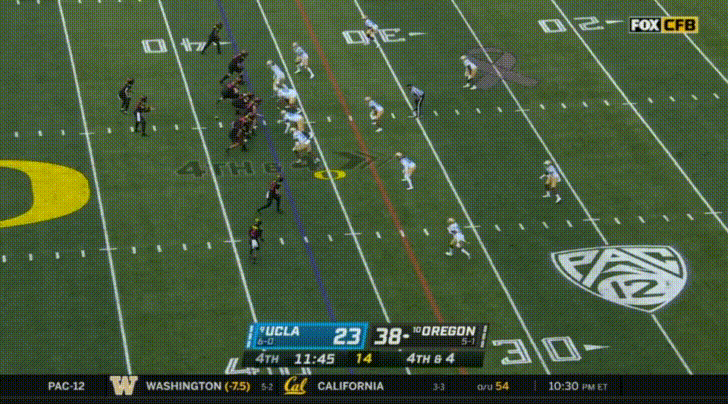
![[speed output image] [speed output image]](https://substackcdn.com/image/fetch/$s_!JvaB!,w_1456,c_limit,f_auto,q_auto:good,fl_lossy/https%3A%2F%2Fbucketeer-e05bbc84-baa3-437e-9518-adb32be77984.s3.amazonaws.com%2Fpublic%2Fimages%2F43665268-bbc2-406a-9ad1-ef64773f4d27_728x406.gif)
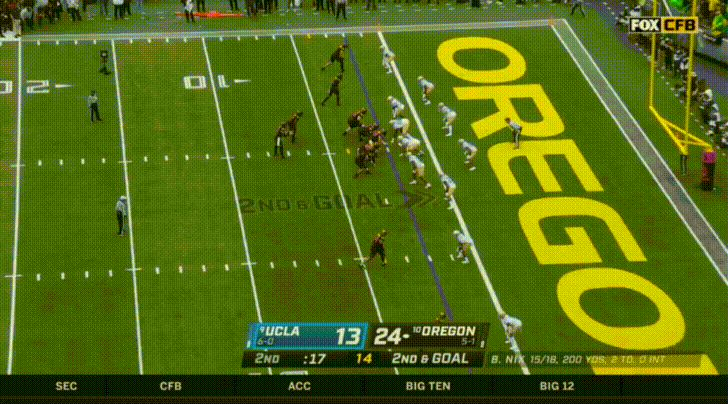
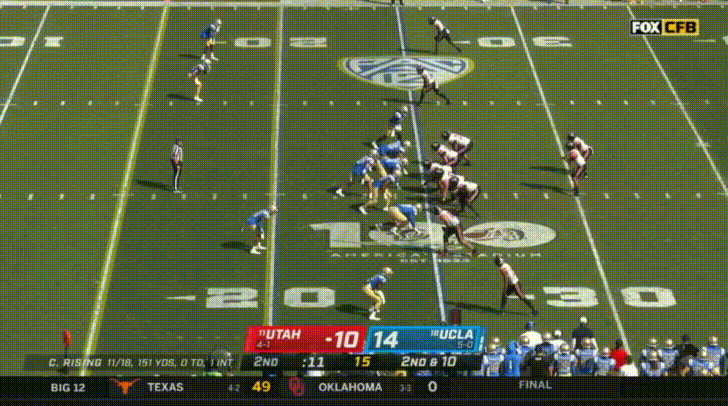
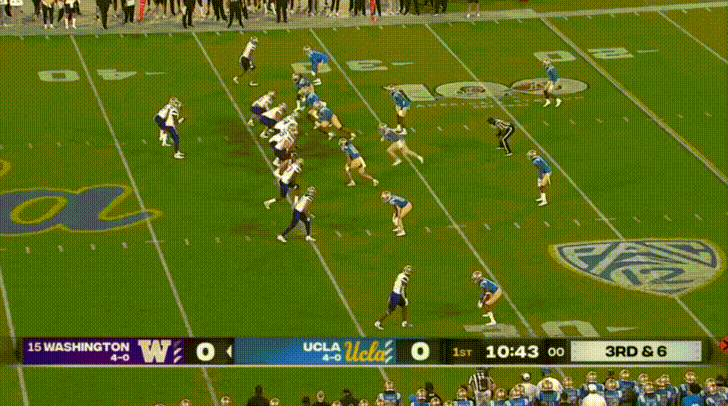
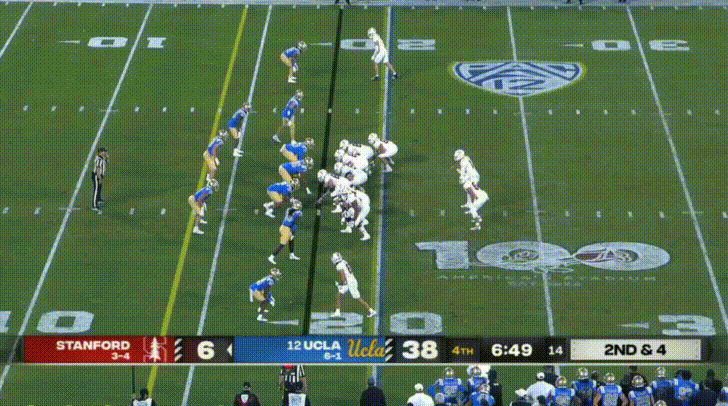
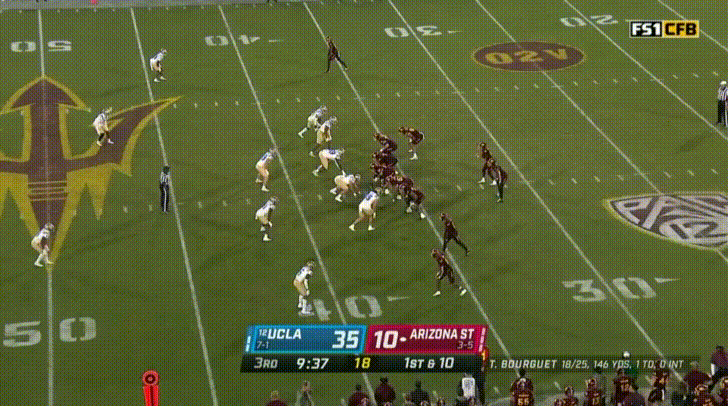
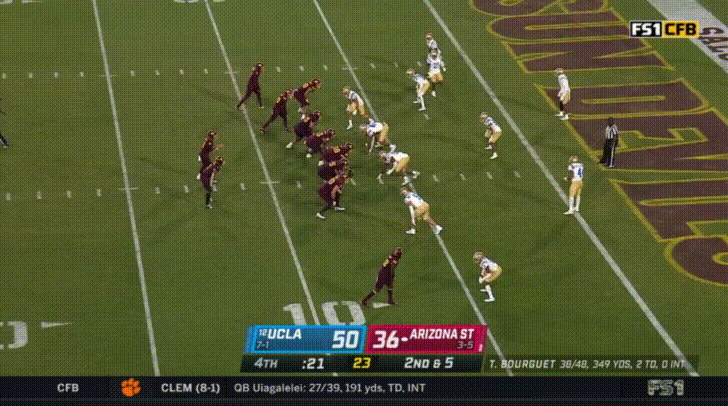
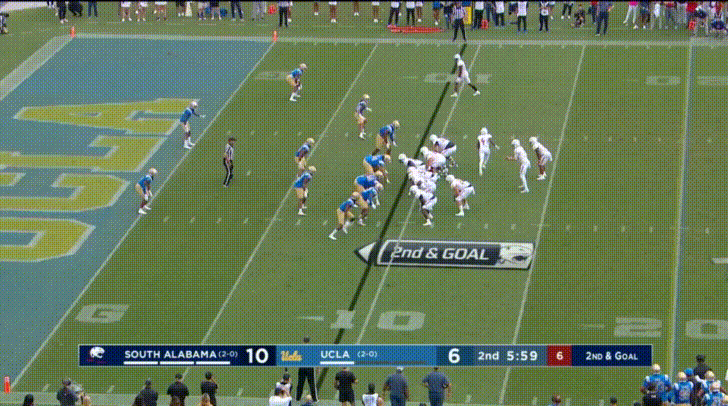
UCLA fans are the worst (and not just in the classroom). I appreciate the accurate and measure tone of this review.
Another great piece of work. Pulitzer on the way!
Happy Thanksgiving!🦃🦃🦃🦃